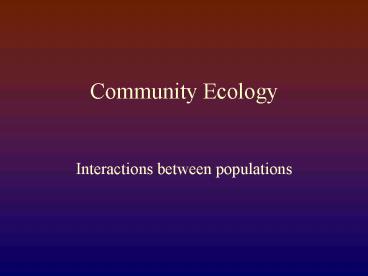Community Ecology - PowerPoint PPT Presentation
1 / 37
Title:
Community Ecology
Description:
If two species are competing, the growth of one population should ... as predator evolves, prey evolves to evade it. Warning coloration and mimicry. Camouflage ... – PowerPoint PPT presentation
Number of Views:39
Avg rating:3.0/5.0
Title: Community Ecology
1
Community Ecology
- Interactions between populations
2
Density dependent factors
- Operate as negative feedback mechanisms
- The population maintains a steady level
- Disease transmission
- Vulnerability to predators
- Food supply
- Over crowding
3
What Controls Population Size and Growth Rate
- Density-dependent factors
- Intra-specific competition
- Food
- Space
- Contagious disease
- Waste production
- Inter specific competition
- Other species interactions
- Density-independent factors
- disturbance, environmental conditions
- Hurricanes
- Floods
- Colder than normal winter
4
(No Transcript)
5
Types of Interactions
- Competition
- Predator-Prey
- Mutualism
- Commensalism
- Parasitism
6
Competition
Natural Selection minimizes competition!
7
Competition
- If two species are competing, the growth of one
population should reduce the size of the other
8
(No Transcript)
9
(No Transcript)
10
Predator-prey
11
Predator-Prey Relationships
- Prey defenses avoid conflict!
- Coevolution
- as predator evolves, prey evolves to evade it
- Warning coloration and mimicry
- Camouflage
12
Predator-Prey Relationships
- Predators can promote diversity by
- keeping competition in check
13
(No Transcript)
14
(No Transcript)
15
(No Transcript)
16
Idealized Predator-Prey Population Graph
17
Predatory-Prey
- If it is a predator-prey relationship, then
the two populations have opposite effects on one
another
18
Mutualism
- Both species benefit
19
(No Transcript)
20
(No Transcript)
21
Mutualism
- If it is a mutually beneficial relationship, then
the two populations increase each others size
22
(No Transcript)
23
Commensalism
- One species benefits, the other is unaffected
24
(No Transcript)
25
Is this mutualism or commensalism?
26
Commensalism
- If the relationship is commensalistic, one
species benefits (the commensal) and the other is
unaffected
27
Parasitism
28
(No Transcript)
29
Test you knowledge!
- What type of relationship?
- A coati eats tree fruit.
- Your dog has a flea
- You use a fast bicyclist to draft off of
30
Carrying Capacity
The number of individuals that a habitat can
support. If the population is a herbivore, K may
depend on the population of plants
31
Community Dynamics
Community a group of populations (both plants
and animals) that live
together in a defined region.
32
Trophic Levels
Eagles
4th trophic level
predator/ tertiary consumer
Foxes
3rd trophic level
predator/ secondary consumer
2nd trophic level
herbivore/ primary consumer
Mice
Plants
1st trophic level
autotroph/ primary producer
33
Trophic Levels
Eagles
4th trophic level
if eagles go extinct, what could happen
to foxes? mice? plants?
Foxes
3rd trophic level
2nd trophic level
Mice
Plants
1st trophic level
34
Trophic Levels
Eagles
4th trophic level
If a new predator on mice is introduced, what
could happen to mice? plants? foxes? eagles?
Foxes
3rd trophic level
2nd trophic level
Mice
Plants
1st trophic level
35
Trophic Levels
Eagles
4th trophic level
If drought caused a dip in plant production, what
would happen to mice? foxes? eagles?
Foxes
3rd trophic level
2nd trophic level
Mice
Plants
1st trophic level
36
Simplified Temperate Forest Food WebWhat
happens to when its a WEB instead of a CHAIN?
Eagle
Wolf
Fox
Shrews
Deer
Caterpillars
Rabbit
Oak seedling
Grasses
Herbs
In long term, balance is restored
37
That is the end!






























